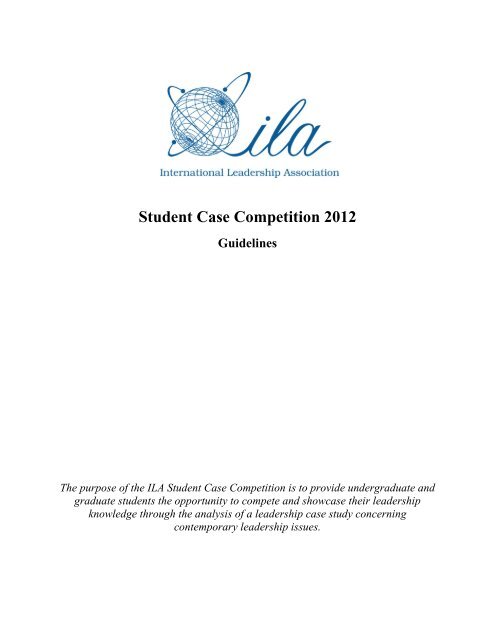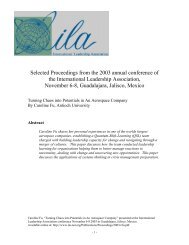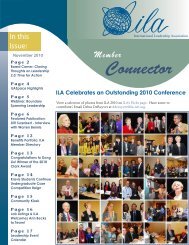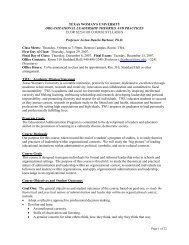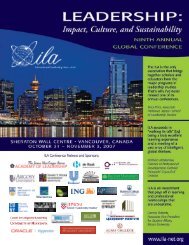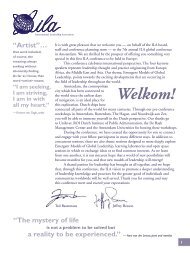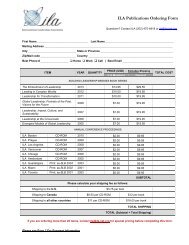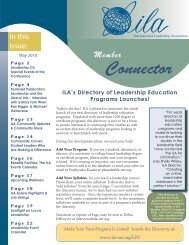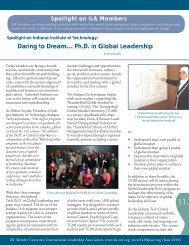Student Case Competition 2012 - International Leadership Association
Student Case Competition 2012 - International Leadership Association
Student Case Competition 2012 - International Leadership Association
You also want an ePaper? Increase the reach of your titles
YUMPU automatically turns print PDFs into web optimized ePapers that Google loves.
<strong>Student</strong> <strong>Case</strong> <strong>Competition</strong> <strong>2012</strong><br />
Guidelines<br />
The purpose of the ILA <strong>Student</strong> <strong>Case</strong> <strong>Competition</strong> is to provide undergraduate and<br />
graduate students the opportunity to compete and showcase their leadership<br />
knowledge through the analysis of a leadership case study concerning<br />
contemporary leadership issues.
ILA <strong>Student</strong> <strong>Case</strong> <strong>Competition</strong> Goals<br />
1. To increase student attendance and networking at the Annual ILA Conference.<br />
2. To advance the study of leadership as a discipline.<br />
3. To provide non-student ILA members and conference attendees an opportunity to help<br />
develop the next generation of leadership scholars and practitioners by providing students a<br />
forum in which they can:<br />
a. Engage in conference dialogue that may strengthen the case analysis.<br />
b. Develop a deeper understanding and appreciation of leadership in various contexts.<br />
c. Apply leadership theory and research to a real-world scenario.<br />
d. Gain experience in presenting ideas and leadership analyses in a professional setting.<br />
e. Receive encouragement and constructive criticism on their case analyses and<br />
presentations.<br />
f. Receive personal leadership knowledge and wisdom from established leadership scholars,<br />
educators and practitioners.<br />
ILA <strong>Case</strong> <strong>Competition</strong> Committee<br />
Thank you to the following members of the planning committee:<br />
● Tiffany Anderson, University of Colorado Boulder<br />
● Jessica Briggs, Claremont McKenna University<br />
● Bridget Chisholm, <strong>International</strong> <strong>Leadership</strong> <strong>Association</strong><br />
● Natalie Coers, University of Florida<br />
● Brent Goertzen, Fort Hays State University<br />
● Dan Jenkins, University of Southern Maine<br />
● Eric Kaufman, Virginia Tech University<br />
● Rob McManus, Marietta College<br />
● Mark Menaldo, Texas A&M <strong>International</strong> University<br />
● Todd Murphy, Northwestern University<br />
● Kerry Priest, Kansas State University<br />
If you have questions related to competition, please direct them to the planning committee chair,<br />
Eric Kaufman, via email: ekaufman@vt.edu.
<strong>Competition</strong> Overview<br />
Team Composition: Each team will be comprised of three to five students. <strong>Student</strong>s may enter<br />
as a team representing their respective college or university, or individuals from multiple<br />
institutions may join together to form a team. Schools may register multiple teams into each<br />
division of the competition (i.e. Undergraduate and Graduate).<br />
<strong>Competition</strong> Divisions: The competition will consist of two divisions: Undergraduate and<br />
Graduate (Master and Doctoral). Teams including students of both levels will compete in the<br />
Graduate <strong>Student</strong> Division.<br />
Registration: The cost to participate is covered with conference registration; however, each<br />
team must register separately via the registration link on the competition website.<br />
Structure: The <strong>Student</strong> <strong>Case</strong> <strong>Competition</strong> is divided into three rounds of competition. The<br />
structure enables students to use campus resources and develop the foundation of their case prior<br />
to the conference, while the best teams will continue to improve their case analyses during the<br />
conference.<br />
Round One – <strong>Case</strong> Study Brief: Registered teams will receive the selected case study<br />
and initial questions on September 17, <strong>2012</strong>. Teams must prepare a case study brief of no<br />
more 1,600 words (excluding references). Please see the Appendix A for guidance on<br />
appropriate content and the criteria used for evaluation. The case study brief must be<br />
submitted electronically for judging no later than October 17, <strong>2012</strong>.<br />
Round Two – Poster Showcase: Each team must prepare a poster of their analysis to be<br />
presented during the <strong>Student</strong> Poster Showcase near the start of the conference. Posters<br />
will be evaluated during the Showcase. Please see Appendix B for more details<br />
concerning poster composition the criteria used for evaluation. The top three teams in<br />
each division will advance and compete in Round 3.<br />
Round Three – Finalists’ Presentations: Finalists will continue building on their case<br />
analysis, using the ILA Conference sessions for further learning and supporting material.<br />
Each team will deliver a 15-minute oral presentation to a panel of judges and participate<br />
in a question and answer discussion of an additional five minutes. These presentations<br />
are open to all ILA Conference attendees, and will be held on Friday evening. A<br />
computer and projector will be provided in each room. Results will be announced on<br />
Saturday during the closing session of the conference. Final results are based on the<br />
cumulative rankings of all competition rounds.
<strong>Case</strong> Preparation: Teams may be advised prior to the competition; however advisers, coaches,<br />
or other individuals may not contribute to any of the team’s products (i.e. case brief, poster, and<br />
presentation). In preparing their submissions, teams may explore any public information source<br />
that would be accessible by a professional consulting group. Teams may consult books or<br />
articles, search libraries, use the Internet, and so forth. Teams are free to receive verbal feedback<br />
on initial drafts and practice presentations.<br />
Team Check-In: A representative from each competing team must check-in and receive final<br />
instructions on Wednesday, October 24, 3:30-4:30 pm, in the Centennial Foyer (poster showcase<br />
location). A <strong>Case</strong> Committee Member will be present at a check-in table in the Foyer to assist<br />
and answer questions at that time.<br />
Awards: The top 3 teams in each category will be recognized during the conference's closing<br />
session for their achievements. The first and second place teams in each category will receive 1-<br />
year ILA memberships for each team member. In addition, the first place team in each category<br />
will receive $1,000 to divide among the team members.<br />
Important Dates:<br />
September 17<br />
October 17<br />
October 24<br />
October 24<br />
October 25<br />
October 26<br />
October 27<br />
<strong>Case</strong> narrative is distributed for analysis<br />
Written case brief due electronically<br />
Team Check-In, 15:30-16:30, Centennial Foyer<br />
Poster Showcase, 18:00-19:30, Centennial Foyer<br />
Finalists in each division posted by 08:00, Mineral Foyer<br />
Presentations by Finalists, 17:00-18:00 (Location TBD)<br />
Winners announced, 13:00-14:30, Centennial Ballroom
Appendix A<br />
ILA <strong>Student</strong> <strong>Case</strong> <strong>Competition</strong><br />
Round One – <strong>Case</strong> Study Brief<br />
After reviewing the designated case for the competition, students are to formulate a response to<br />
the case in the form of a case study brief. Judges will have the opportunity to review and score<br />
each team’s Round One submission prior to arrival at the conference. Judges will submit a rank<br />
order of teams based on the written brief prior to the poster showcase.<br />
Written submission: The case study brief should be no more than 1,600 words (excluding<br />
references) and must be submitted electronically via an online survey form. Teams should use<br />
the Publication Manual of the American Psychological <strong>Association</strong> (APA) to guide preparation<br />
of the case study brief, particularly with regard to crediting sources.<br />
Round One Judging Criteria<br />
CRITERIA WEIGHT CONSIDER THIS…<br />
Rationality and logic of points and 30% Are the suggestions or observations made feasible to<br />
recommendations<br />
implement or change<br />
Are sources noted and points supported<br />
Connection made to related<br />
40% Is the theory to practice/application connection made<br />
leadership theory and research<br />
Awareness of risks or limitations<br />
of points made<br />
Connection to conference theme<br />
or experience<br />
Professionalism (grammar,<br />
spelling, APA formatting, etc.)<br />
10% Are participants aware of the implications of their<br />
actions/decision Were they strategic<br />
10% Is a connection made to relate personal experience or<br />
the conference theme to the analysis or<br />
recommendations<br />
10% Is the content formatted professionally Following<br />
provided instructions
Appendix B<br />
ILA <strong>Student</strong> <strong>Case</strong> <strong>Competition</strong><br />
Round Two – Poster Showcase<br />
The poster showcase offers student teams the opportunity to share their work on the case with the<br />
ILA membership at the conference. The poster showcase provides a location for discussion and<br />
questions from conference participants. Judges will visit with each team about their poster<br />
during the showcase to ask questions and discuss their perspective on the case. At the<br />
conclusion of the showcase, judges will submit a rank order of the teams. The Round One and<br />
Round Two rankings will be combined to determine the advancing teams in the competition.<br />
For guidance on preparing an effective poster, see http://www.ncsu.edu/project/posters. The<br />
poster should be no larger than 4 feet high by 4 feet wide. It should encompass the general ideas<br />
presented in the written brief submission. Self-standing boards, 4 feet wide by 4 feet high, will<br />
be provided at the conference. Teams should bring their own tacks or Velcro to attach the poster<br />
to the board.<br />
Round Two Judging Criteria<br />
CRITERIA WEIGHT CONSIDER THIS…<br />
Organization of content 25% Does the poster design flow well Can someone understand<br />
the case if you are not present<br />
Persuasive strength of<br />
recommendations<br />
15% Are the participants knowledgeable of and believe in their<br />
recommendations<br />
Clarity of presentation 25% Does the poster summarize the recommendations<br />
Team participation 10% Do all members contribute to the presentation<br />
Response to questions 25% Do students fully understand the case, their analysis, and<br />
recommendations
Appendix C<br />
ILA <strong>Student</strong> <strong>Case</strong> <strong>Competition</strong><br />
Round Three – Finalists’ Presentations<br />
The final presentation allows teams to formally present their thoughts on the case. The formal<br />
presentation allows 15 minutes for each team, in addition to 5 minutes of questions from the<br />
judges. <strong>Student</strong> teams should have a strong, prepared presentation on their analysis of the<br />
situation and utilize the final 3-5 minutes of the presentation to address any additional prompts<br />
provided for the final round of competition. At the conclusion of the presentations, judges will<br />
submit a rank order based on the final presentation; this ranking will be combined with the<br />
rankings from Round One and Round Two to determine the final results of the competition.<br />
Round Three Judging Criteria<br />
AREAS CRITERIA WEIGHT CONSIDER THIS…<br />
Analysis Organization of content 5% Is the content formatted professionally<br />
Following provided instructions<br />
Evidence presented in 5% Are sources noted and points supported<br />
support of points made<br />
Connection made to<br />
leadership literature<br />
25% Is the theory to practice/application<br />
connection made<br />
Connection to conference<br />
sessions or experience<br />
10% Is a connection made to relate the conference<br />
theme to the analysis or recommendations<br />
Awareness of risks or<br />
limitations of points made<br />
5% Are participants aware of the implications of<br />
their actions/decision Were they strategic<br />
Rationality and logic of 10% Are the suggestions or observations made<br />
recommendations<br />
feasible to implement or change<br />
Presentation Organization of content 10% Does the presentation flow Can someone sit<br />
down and understand their view without<br />
knowing the background<br />
Persuasive strength of<br />
recommendations<br />
5% Are the participants knowledgeable of and<br />
believe in their recommendations<br />
Clarity of presentation 10% Is the presentation direct Easily understood<br />
Are recommendations clearly identified and<br />
explained<br />
Team participation 5% Do all members contribute to the<br />
presentation<br />
Response to questions 10% Do students fully understand the case, their<br />
analysis, and recommendations Can<br />
participants think on their feet


